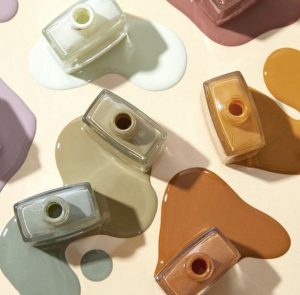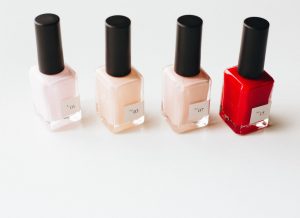Today, there are so many choices available when entering a nail salon. Are you stuck between choosing gel nails or acrylic nails for your next manicure? Learn about the pros and cons of gel vs. acrylic nails and get a quick side-by-side comparison guide from professional nail technicians at sundays studios.
While gel nails and acrylic nails aren’t all that different on the surface, they do have some unique distinctions that can make one or the other a better option based on what you’re looking to achieve. Below, we’re explaining the key differences between gel and acrylic nails, so you know exactly what to ask for at your next manicure appointment.
Choosing Between Gel vs. Acrylic Nails
So what’s the real difference between gel vs. acrylic nails? Is one better than the other? This article will consider the many factors that influence the look and feel of two of the nail industry’s most popular manicure styles– explaining everything from application, and maintenance, to removal.
Composition and Application
Though both stunning choices, gel nails and acrylic nails are different in composition. Ultimately, whether you prefer the flexible, glossy finish of gel nails vs. acrylics nails’ resilient, customizable nature, the composition sets the foundation for your nail transformation journey.
Gel nails are created using a liquid polymer substance that hardens when exposed to UV or LED light. The gel application process involves applying a gel base coat, followed by the colored gel polish, and then a gel top coat, while curing each layer under the appropriate light.
Acrylic nails are made by combining a liquid monomer with a powder polymer. This mixture creates a malleable, wet sand-like consistency that can be shaped over the natural nails or extensions. Once applied, the acrylic hardens through a chemical reaction with the air.
Durability and Strength
One of the key factors to consider when it comes to choosing gel vs. acrylic nails is the durability and strength of the manicure. Especially for people who use their hands more regularly to work, exercise, cook, and do regular tasks, it might be worth understanding what options are available in order to figure out what will be best for your lifestyle.
Gel nails are known for their flexibility so that the manicure is less prone to breaking. This makes gel nails a perfect choice for people who want more protection than regular nail polish but still want their nails to be a natural thickness. Typically, a gel manicure will need a touch-up every 2 to 3 weeks to maintain their pristine look.
Acrylic nails are a more robust and resilient manicure option that offers strength against daily wear and tear. People tend to choose acrylic nails for long-lasting manicure results, since the manicure will need a touch-up every 3 to 4 weeks.
Appearance and Finish
When you are faced with the gel vs. acrylic nails dilemma, feel better knowing that both options are extremely versatile and customizable when it comes to appearance and finish.
Gel nails tend to resemble real nails more closely, and they are the middleground between regular nail polish and acrylic nails in terms of appearance. Nowadays, gel nail polishes come in every color imaginable and can have a glossy or matte finish depending on each individual’s style.
Acrylic nails are customizable in any shape or length–ranging from shorter natural nails to longer nail extensions–allowing for various designs and finishes. Depending on the salon, the acrylic powder may contain color pigment or nail polish can be applied on top of the acrylics. Finally, a glossy or matte finish is applied at the end of the manicure.
Maintenance and Removal
After getting your manicure, whether it be gel or acrylic nails, it is helpful to know what the procedures for maintenance and removal are so that you can protect both the longevity and health of your nails.
Gel nails are less prone to breaking, but they still require good maintenance such as not allowing the manicure to be exposed to harsh chemicals or excessive water. This will ensure that the gel manicure does not separate from the nail bed and start to lift before the 2 to 3 week mark.
When it is time to remove gel nails, the process is relatively simple and safe. The tools needed to remove gel nail polish include acetone, a file, and (optionally) a stick or cuticle pusher. By soaking the nails in acetone first, the gel nail polish will soften until it can be pushed easily off the nails. This process takes a minimum of 15 to 20 minutes. We never recommend rushing to scrape off the gel nail polish, as harsh removal can damage the health of your nails. Instead, soak the nail for longer until the gel is easy to remove.
Acrylic nails are very durable, but this means that you might see your manicure grow out before it is ready to be removed. Therefore maintenance includes regularly filing and shaping the nails as time passes in between acrylic applications. Be cautious to avoid putting excessive pressure on nail extensions to prevent breakage as they grow out.
Removing acrylic nails requires patience and care, as well as acetone and an e-file. Since acrylic manicures are so durable, the process of removing them will take a minimum of 30 to 45 minutes. It is advisable to seek professional removal assistance for acrylics to ensure a safe and effective removal process.
After removing your manicure, it is important to promote good nail health. Acetone can be harsh and drying on skin and nails, so please remember to nourish your natural nails. Our sundays studio nail care line is specially designed to help to moisturize the nails and cuticles to repair any damage that occurred during the removal process: Shop sundays non-toxic nail care!
Cost
Let’s talk about the pricing of gel vs. acrylic nails. Gel nail polish on natural nails can cost anywhere from $30 to $70 depending on where you live and what salon you go to. Acrylic nails on natural nails can cost anywhere from $30 to $100 or more, depending on the salon, what length you get and what other services you pair them with. Acrylic nail fill-ins that blend the existing manicure with the grown-out nail typically cost $30 to $60 as a baseline.
Though this is not always the case, gel manicures tend to be more expensive than acrylic manicures for two reasons: the application of gel nail polish requires more equipment and more time. Additionally, acrylic manicures can be less expensive over time because of the reduced price of fill-in applications.
Allergies and Sensitivities
Before choosing between gel vs. acrylic nails, try a patch test or consultation to determine whether the manicure option is safe for you. It is always better to be safe than sorry!
Gel nails are generally considered hypoallergenic and less likely to cause adverse reactions. The gel nail polish formula tends to be milder and more gentle on the natural nails, making it a suitable choice for individuals with sensitive skin or those prone to allergies. However, the UV lamp used to cure gel nails can emit harmful rays onto the hands and nails. We recommend that people wear fingerless gloves or sunscreen with an SPF of 30 or higher while getting a gel manicure.
Acrylic nails can pose a higher risk of allergic reactions and sensitivities. The liquid monomer used in the application process emits a strong odor that might be problematic for individuals who experience repeated and prolonged exposure to the chemicals. The powder polymer also can irritate the eyes and lungs, so we recommend wearing a mask and glasses for protection. If you notice any redness, swelling, itching, or difficulty breathing after having your acrylic manicure is applied, remove them immediately and consult a doctor.
A Quick Comparison of Gel and Acrylic Nails
If you are about to head into the salon and need a quick side-by-side comparison of gel vs. acrylic nails, we have got you covered. Listed below is a short summary of all the information explained in this article.
| Gel Manicure | Acrylic Manicure |
| A fluid polymer substance, and the manicure cures in UV and LED light. | A powder polymer and liquid monomer are combined, and the manicure cures in the air. |
| Natural and flexible thickness | Strong and durable thickness |
| Customizable color and design | Customizable length, color, and design |
| Lasts up to 2 to 3 weeks | Lasts up to 3 to 4 weeks |
| Removal time of 15 to 20 minutes | Removal time of 30 to 45 minutes |
| Costs $30 to $70 | Costs $30 to $100 |
| Caution: wear gloves or sunscreen | Caution: wear a mask and glasses |
Conclusion
In summary, there are no right answers when comparing between gel vs. acrylic nails. Both types of manicures have their pros and cons, and the best option depends on each individual’s needs, preferences, and budget.




